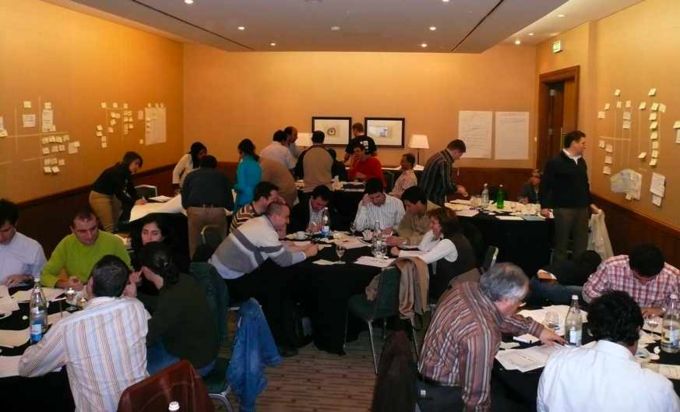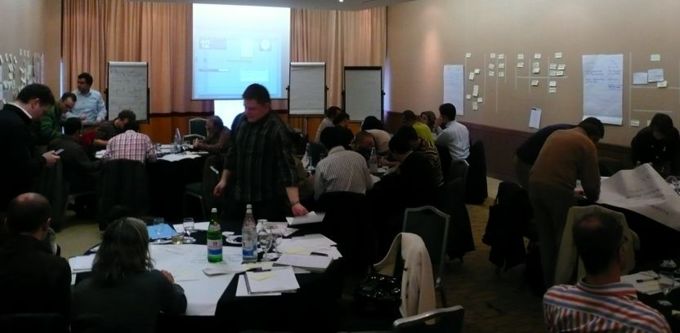|
|
| (35 intermediate revisions by the same user not shown) |
| Line 1: |
Line 1: |
| − | == Maximum Participants ==
| |
| − | 16
| |
| − |
| |
| − |
| |
| | == Contact Information == | | == Contact Information == |
| − | Craig Larman, craig@craiglarman.com. +1 214 914 7593 | + | Craig Larman, craig@craiglarman.com |
| − | | + | <br> |
| − | | + | <br> |
| − | == Course Notes and Text ==
| |
| − | * There is a PDF version of the PPTs to print; i will provide the PDFs and printing instructions.
| |
| − | | |
| − | * There is a course text accompanying the seminar ([http://www.amazon.com/Applying-UML-Patterns-Introduction-Object-Oriented/dp/0131489062/ref=sr_1_1/002-2801511-2159202?ie=UTF8&s=books&qid=1194351090&sr=1-1 Applying UML & Patterns: Introduction to Object-Oriented Analysis & Design, & Iterative Development]) that each student will use frequently within the course. Doing a bulk purchase at Amazon is a good value.
| |
| − | | |
| − | * The customer is responsible obtain 1 copy of this for each student before the course. The text is actively used in the course, and must be brought by the students to the class.
| |
| − | | |
| − | | |
| | == Room, Walls, Whiteboards == | | == Room, Walls, Whiteboards == |
| − | This is a hands-on course in which students spend significant time in small teams of 3 or 4 at LARGE “whiteboard” areas, doing modeling work. e.g., if 16 students, 4 teams.
| + | * People will be organized into table-teams, averaging 5 people per team. Thus, we need Num/People tables; e.g., 6 or 7 tables if 35 people. The tables are ideally in separate islands, circular or square, with a team at each. |
| − | Thus, a prime need is a room with these qualities:
| |
| − | | |
| − | Very large “whiteboard” areas. Very large “whiteboard” areas. THIS IS NOT AN OPTION; THE COURSE CAN’T RUN UNLESS THIS IS SATISFIED.
| |
| − | | |
| − | Either:
| |
| − | * 2 large (e.g., each is approximately 1 meter x 3 meter; 4 foot x 8+ foot) whiteboards for each team.
| |
| | | | |
| − | * Or, lots of open wall space to cover the walls (6 meters or 16+ feet per team) with “write-on static cling sheets” that create a temporary whiteboard (see Other Supplies for details). These special thin plastic sheets have a static cling that makes them stick to walls (and glass) and can be used to wallpaper large areas, creating temporary “whiteboards”. | + | * Don’t make it a crowded room; there are a number of activities/exercises that involve the teams moving around. |
| | | | |
| − | A combination of the above to achieve the goal; e.g., 1 large whiteboard + 8 feet of wall space for each team.
| + | * There are several wall activities/exercises, involving flip chart paper or PostIt Note layouts; each team needs some unencumbered clear wall space for this. To be clear: There must be lots of clear empty wall space, and we must be able to use the walls, and put things on the walls. |
| − | Since the walls are of prime importance, a room with many tables touching the walls (making wall access awkward) or un-removable art or posters is not suitable.
| + | <br> |
| | + | <br> |
| | | | |
| − | The walls may be unadorned plain paint, wallpaper or glass, but not cloth, so that the cling sheets (if there are not giant whiteboard) will cling and can be written upon.
| + | == Supplies for the Coach/Speaker == |
| | + | Read this: [[Supplies - for Coach Use]] |
| | + | <br> |
| | + | <br> |
| | | | |
| − | The room needs to be relatively large; each team is using lots of wall space.
| + | == Supplies for Each Table of Participants == |
| − | Rooms with large glass windows representing a wall are OK, as the cling sheets can cling to glass.
| + | Per Team-Table (e.g., of 5 people): |
| | + | * 2 packages of '''3x5 inch Yellow-only''' Post-It notes |
| | | | |
| | + | * 5 BLACK "Sharpie" style small fine-tipped black marker pens |
| | | | |
| − | == Projectors and Screens ==
| + | * 2 BLACK WHITEBOARD marker pens |
| − | * 1 computer projector.
| + | <br> |
| − | * 1 transparency “overhead” projector. (NB: required if Craig Larman is teaching. But, check with the coach otherwise -- not all coaches use transparencies)
| + | <br> |
| − | * 1 white projector screen at the front of the room (for the computer and overhead projector). | |
| − | * Ability to place the two projectors in a room-central location for suitable display onto the screen.
| |
| − | | |
| | | | |
| | == Table Layout == | | == Table Layout == |
| − | * Tables should not be against the walls; we are using the walls as a main working area in this course. | + | * Round tables are ideal, but we can live with rectangular layouts |
| − | | |
| − | * A “U” shape organization of the tables is optimal for education, and thus required. Least optimal is rows of tables facing an instructor; this is not allowed.
| |
| − | | |
| − | * A "teacher table" near the front in the open space of the “U” shape of tables, for placing the projectors and coach laptop.
| |
| | | | |
| | + | * Tables should not be against the walls; we are using the walls as a working area in this course. |
| | | | |
| | + | * Distribute the tables throughout the room |
| | + | <br> |
| | + | <br> |
| | == Computers, Software and Networking == | | == Computers, Software and Networking == |
| − | * Computers are used for one phase, for a critical 4-8 hour TDD and refactoring exercise, usually on Wednesday and Thursday (sometimes Tuesday-Wednesday, depending on class speed). Therefore, it is useful that we DO NOT have large permanent computers in the room (because we need lots of room for the group modeling exercises). Rather, it is useful that laptops are brought in for this session, though if there is no alternative, we’ll live with them in the room fulltime. We only need (and want) 1 computer for each 2 students; e.g., if 16 students, then 8 computers. Often, it is possible for students to bring their own laptop. | + | * Internet access for the coach; it is not needed for the participants |
| − | | + | <br> |
| − | * No network is required.
| + | <br> |
| − | | |
| − | Software:
| |
| − | If Java group:
| |
| − | * Latest release version of Java Runtime (JRE)
| |
| − | ( Latest release version of Eclipse
| |
| − | | |
| − | If C++ group:
| |
| − | * we will do the exercises in Java (to avoid burning hours on awkward/slow tool setup and use); Java is very similar to C++, and sufficient for the educational goals (of introducing the idea of TDD)
| |
| − | | |
| − | If .NET group:
| |
| − | * Visual Studio in C#
| |
| − | | |
| − | | |
| − | == Other Supplies ==
| |
| − | * Overhead transparency projector (plastic) sheets or roll. (NB: required if Craig Larman is teaching. But, check with the coach otherwise -- not all coaches use transparencies)
| |
| − | * Overhead projector plastic sheet pens. (NB: required if Craig Larman is teaching. But, check with the coach otherwise -- not all coaches use transparencies)
| |
| − | * flip chart stand
| |
| − | * flip chart paper
| |
| − | * masking tape
| |
| − | * 8 whiteboard erasers
| |
| − | | |
| − | If no whiteboards, then 4 packages of “Write-On Cling Sheets” by Avery or National Brand, or equivalent (in Europe, “Magic-Chart” by LegaMaster is a common brand, though there are others); These are available at most office supply stores, or can be ordered over the Web. For example:
| |
| − | | |
| − | * http://www.cleansweepsupply.com/pages/skugroup31385.html (Write-On Cling Sheets)
| |
| − | * http://www.legamaster.com/productinfos.html (Magic-Chart)
| |
| − | | |
| − | If insufficient whiteboards, then please pay attention to getting the Cling Sheets.
| |
| − | THESE MAY TAKE AWHILE TO FIND, SO SEARCH EARLY.
| |
| − | | |
| − | * 8 black erasable whiteboard markers. EXPO brand (very common in USA) seems to erase best when using the Avery Write-On Cling Sheets. If you are using the LegaMaster Magic-Charts, then “1 Classic” whiteboard markers (common in Europe) work well. The particular ink of the markers doesn’t erase equally well on all cling sheet types. Strive for EXPO if Avery, or “1 Classic” if LegaMaster.
| |
| | | | |
| | + | == Pictures of Room Setup == |
| | + | [[Image:Csm1.jpg | 680px| ]] |
| | | | |
| − | == Picture of Classroom Setup ==
| + | [[Image:Csm2.jpg | 680px| ]] |
| − | [[Image:Course room - modeling.jpg | 680px| ]] | |

